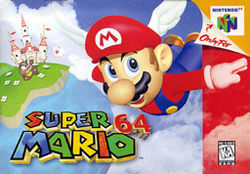Super Mario 64: Difference between revisions
mNo edit summary |
m (Fixing the interwiki) |
||
| Line 18: | Line 18: | ||
|requirements = | |requirements = | ||
|input = | |input = | ||
|interwiki = | |interwiki = supermariowiki | ||
|interwikiname = | |interwikiname = Super Mario Wiki | ||
|interwikipage = Super Mario 64 | |interwikipage = Super Mario 64 | ||
}} | }} | ||
Revision as of 10:30, April 12, 2012
| Super Mario 64 | |
|---|---|

| |
| Developer(s) | Nintendo EAD |
| Publisher(s) | Nintendo |
| Designer(s) | Shigeru Miyamoto |
| Released | Template:Japan June 23, 1996 Template:NA September 26, 1996 Template:Europe/Template:Australia March 1, 1997 |
| Genre(s) | Console Platform game |
| Ratings | ESRB: K-A, E |
| Platform(s) | Nintendo 64 |
| Article on Super Mario Wiki | Super Mario 64 |
Super Mario 64 (スーパーマリオ64, Sūpā Mario Rokujūyon) is a 3D platformer game for the Nintendo 64. It was released in Japan on June 23, 1996 and was then released to the United States on September 26, 1996.
In the Super Smash Bros. series
In Super Smash Bros.
Many of Mario's attack moves originates from this game and has appeared in all three smash games. These moves include:
- Mario's neutral attack where he does a punch, punch, kick.
- Mario's down smash when he is attacking while crouching.
- Mario's dash attack when he runs, then crouches, then attacks.
- Mario's back throw when in the three boss battles with Bowser, he grabs Bowser's tail, swings it around and throws him in a direction.
- Mario's sleeping position, where he falls asleep after standing still or being idle.
- The design of the coins when Mario or Luigi preforms their up special move.
One of the three special forms for Mario, Metal Mario, appears as a boss in SSB64 and Melee.
Mario and Luigi's voice clips can be heard although Luigi doesn't appear in Super Mario 64 but his voice clips are a sped up version of Mario's clips.
In Super Smash Bros. Melee
Mario can wall jump in Melee and Brawl.
The Metal Box originated from this game and appeared in Melee and Brawl as an item.
Peach's Castle appears in Melee and Rainbow Cruise appears in both Melee and Brawl.
The athletic levels and sliding themes from this game can be heard as music for Rainbow Cruise.
In Super Smash Bros. Brawl
The main music theme can be heard as music for Delfino Plaza. It can be unlocked by playing 50 total hours of brawling.